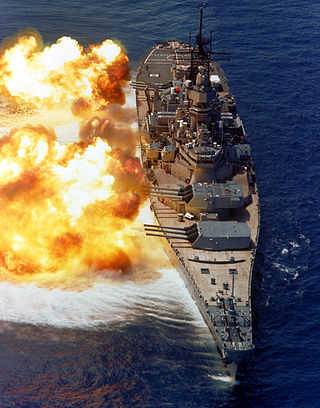
The 16"/50 caliber Mark 7 – United States Naval Gun is the main armament of the Iowa-class battleships and was the planned main armament of the cancelled Montana-class battleship.

The 4″/50-caliber gun was the standard low-angle, quick-firing gun for United States, first appearing on the monitor Arkansas and then used on "Flush Deck" destroyers through World War I and the 1920s. It was also the standard deck gun on S-class submarines, and was used to rearm numerous submarines built with 3-inch (76 mm) guns early in World War II. United States naval gun terminology indicates the gun fired a projectile 4 inches in diameter, and the barrel was 50 caliber. 4x50 meant that the barrel was 200 inches long, or 16 feet long.

The 14-inch/45 caliber gun,, whose variations were known initially as the Mark 1, 2, 3, and 5, and, when upgraded in the 1930s, were redesignated as the Mark 8, 9, 10, and 12. They were the first 14-inch (356 mm) guns to be employed by the United States Navy. The 14-inch/45 caliber guns were installed as the primary armament aboard all of the United States Navy's New York-class, Nevada-class, and Pennsylvania-class battleships. The gun also saw service in the British Royal Navy, where it was designated BL 14 inch gun Mk II.

The 14"/50 caliber gun was a naval gun mounted on New Mexico and Tennessee-class battleships. These ships also featured the first "three-gun" turrets, meaning that each gun in each turret could be "individually sleeved" to elevate separately. The 14"/50 caliber guns were designated as Mark 4 and 6, with later versions known as Mark 7, 11, and B. These guns were more powerful than the main gun mounted on the previous three classes of US battleships, the 14"/45 caliber gun.

The 16"/50 caliber Mark 2 gun and the near-identical Mark 3 were guns originally designed and built for the United States Navy as the main armament for the South Dakota-class battleships and Lexington-class battlecruisers. The successors to the 16"/45 caliber gun Mark I gun, they were at the time among the heaviest guns built for use as naval artillery.

The 16"/45-caliber Mark 6 gun is a naval gun designed in 1936 by the United States Navy for their Treaty battleships. It was introduced in 1941 aboard their North Carolina-class battleships, replacing the originally intended 14"/50-caliber Mark B guns and was also used for the follow-up South Dakota class. These battleships carried nine guns in three three-gun turrets. The gun was an improvement to the 16"/45-caliber Mark 5 guns used aboard the Colorado class, and the predecessor to the 16"/50-caliber Mark 7 gun used aboard the Iowa class.

The Type 41 3-inch (76 mm) naval gun otherwise known as the 8 cm/40 3rd Year Type naval gun was a Japanese dual-purpose gun introduced before World War I. Although designated as 8 cm (3.15 in), its shells were 76.2 mm (3 in) in diameter.
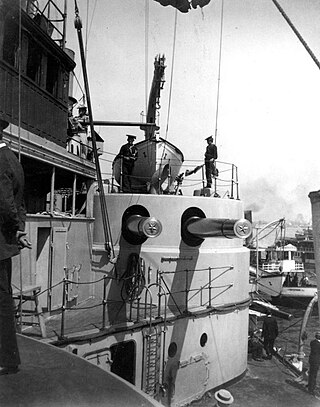
The 8"/35 caliber gun Mark 3 and Mark 4 were used for the main batteries of the United States Navy's first armored cruisers and the secondary batteries for their first battleships, the Indiana-class. The 8"/40 caliber gun Mark 5 initially armed the Pennsylvania-class armored cruisers.
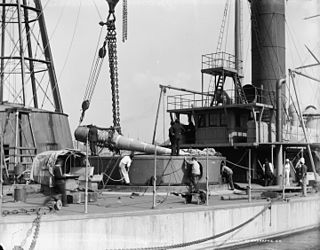
The 10"/31 caliber gun Mark 1 Mod 1 and the 10"/35 caliber gun Mark 1 Mod 2 were both used for the primary batteries of the United States Navy's Amphitrite-class monitor Miantonomoh. The 10"/30 caliber gun Mark 2 was used as main armament on the remaining Amphitrite-class monitors, the monitor Monterey, and the armored cruiser Maine.

The 12"/35 caliber gun were used for the primary batteries of the United States Navy's "New Navy" monitors Puritan and Monterey and the battleships Texas and Iowa.

The 8"/45 caliber Mark 6 gun were used for the secondary batteries of the United States Navy's last pre-dreadnought battleships and refitted in older armored cruisers main batteries.

The 10"/40 caliber gun Mark 3 was used for the main batteries of the United States Navy's last generation of armored cruisers, the Tennessee-class. The Mark 3s were the last, and most powerful, 10-inch (254 mm) guns built for the US Navy.

The 7"/44 caliber gun Mark 1 and 7"/45 caliber gun Mark 2 were used for the secondary batteries of the United States Navy's last generation of pre-dreadnought battleships, the Connecticut-class and Mississippi-class. The 7-inch (178 mm) caliber was considered, at the time, to be the largest caliber weapon suitable as a rapid-fire secondary gun because its shells were the heaviest that one man could handle alone.

The 6"/40 caliber gun Mark 4 were used for the secondary batteries of the United States Navy's Indiana-class and Illinois-class battleships. They were also used as the main battery on the Cincinnati-class protected cruisers.
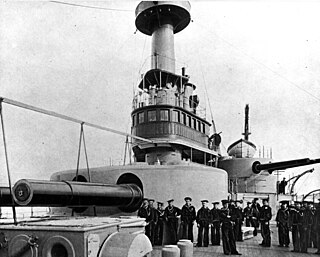
The 13"/35 caliber gun Mark 1 was used for the primary batteries on eight of the first nine battleships in the United States Navy, Indiana-class, Kearsarge-class and Illinois-class; USS Iowa (BB-4) used the 12-inch (305 mm)/35 caliber gun.
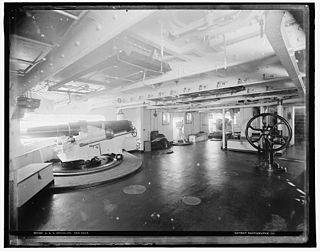
The 5″/40 caliber gun were used in the secondary batteries of the United States Navy's early battleships, armored cruisers, protected cruisers, unprotected cruisers, and auxiliary cruisers.

The 5"/50 caliber gun was the first long barrel 5-inch (127 mm) gun of the United States Navy and was used in the secondary batteries of the early Delaware-class dreadnought battleships, various protected cruisers, and scout cruisers. They were also refitted in the secondary batteries of the armored cruiser New York and the New Orleans-class protected cruisers. They were later used on cargo ships, store ships and unclassified auxiliaries during World War II as well as in emergency coastal defense batteries.
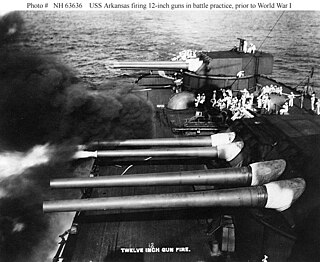
The 12"/50 caliber Mark 7 gun was a United States Navy's naval gun that first entered service in 1912. Initially designed for use with the Wyoming class of dreadnought battleships, the Mark 7 also armed the Argentine Navy's Rivadavia-class battleships.

The 6"/50 caliber gun Mark 6 and Mark 8 were used for the secondary batteries of the United States Navy's Maine-class and Virginia-class battleships, as well as the Pennsylvania-class and Tennessee-class armored cruisers. They were also used as the main battery on the St. Louis-class protected cruisers.
The 18"/48 caliber Mark 1 – United States Naval Gun was the initial name and design for a large caliber naval gun in the early 1920s. After the Washington Naval Treaty prohibited the development of guns larger than 16 in (406 mm), the gun was relined and finished as a high velocity 16"/56 Mark 4 gun. After the start of World War II, the gun was again relined to 18" and tested with a new Super Heavy Shell. The gun in its final form is currently displayed at the Dahlgren Naval Weapons Facility in Virginia.



















